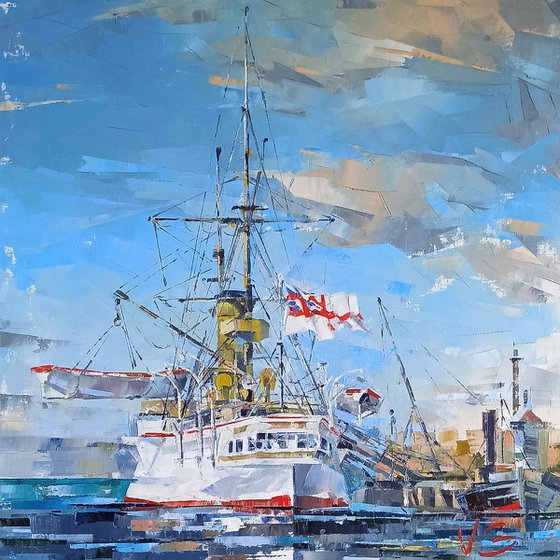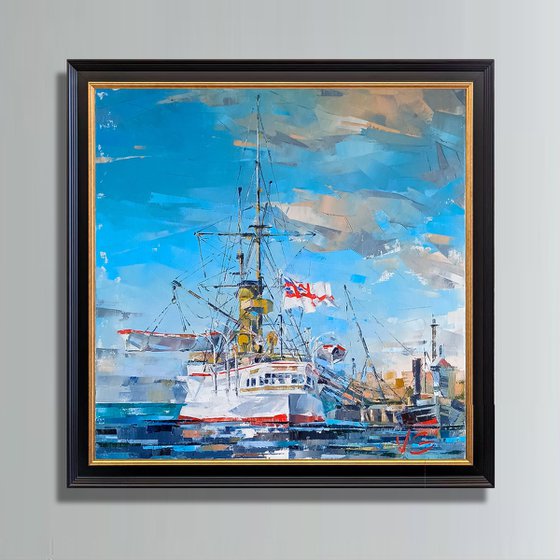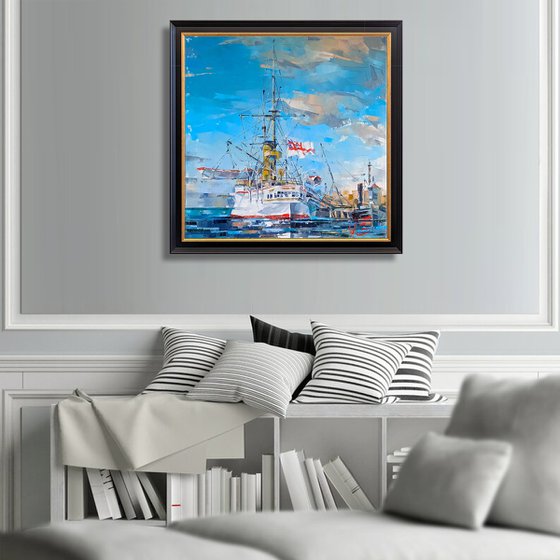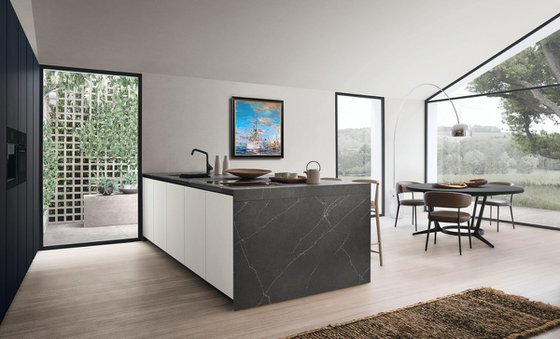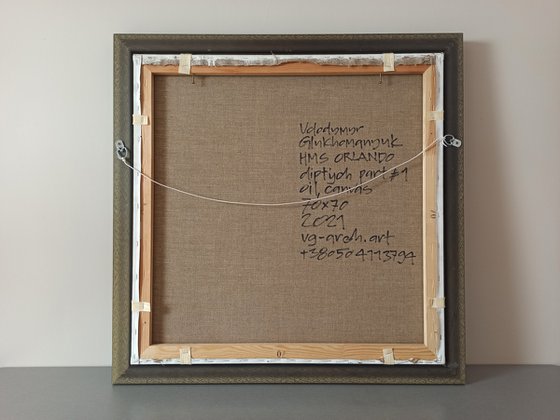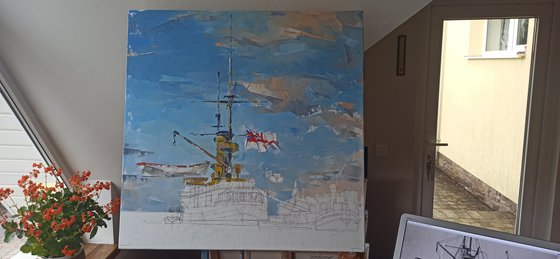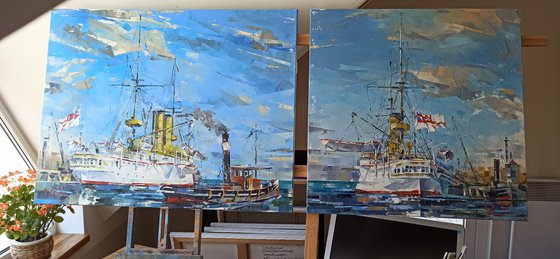- By medium
- By subject
- By budget
- Sales
- Gift cards
- Discover all art
- Artists
- Editors’ picks
- Ideas
Original artwork description:
My oil painting depicts a romantic scene based on the docking at port of the Royal Navy armored cruiser HMS ORLANDO. This is my favorite period: the transition from sailing to the steam fleet and its lightning-fast development at the turn of the 18th and 19th centuries. The desire to show the beauty of the hull contour, its elegance, despite its combat mission, to emphasize the whiteness of the sides with the play of light and shadow, to depict everyday life in the navy, inspired me to create this artistic canvas. I deliberately brightened the sky to give the painting a romantic feel. The painting is part of the diptych. The second canvas with the same plot, but ... But with a changed perspective angle of the cruiser hull and with a tug in the foreground. The canvases of the diptych complement each other. They can be located side by side, they can be spaced through a window opening, or in different rooms. Due to the bright palette and constructiveness of the individual painting technique with a palette knife, they can become accent details of the interior.
A bit of history:
Cruisers of the "ORLANDO" type were intended mainly to protect the trade routes of Great Britain and therefore had a sufficiently long range. Five of them: AUSTRALIA, GALATEA, NARCISSUS, ORLANDO, UNDAUNTED - were approved for construction in 1885, the last two - IMMORTALITE and AURORA - a year later. The project envisaged the construction of ships with a steel hull with a displacement of 5040 tons, equipped with two-cylinder IC steam engines with a capacity of 7500 hp, a coal supply of 440 tons and weapons in the composition of the guns: 9.2-inch 18-ton and 6-inch 4-gun, 5 ton. During the construction of the ships, the configuration was changed by installing three-cylinder machines of the TE type with a capacity of 8,500 hp, as well as options for 20-ton (9.2 inches) and 5-ton (6 inches) guns. This resulted in an increase in displacement to 5,535 tons and an increase in draft of 0.46 m (18 in).
These ships were created on the basis of an enlarged design of the MERCEY-class armored cruisers with additional side armor in addition to the deck armor. More successful, compact and, above all, cheaper than previous Royal Navy armored cruisers.
Tactical and technical data:
Displacement was 5600 tons. Length between perpendiculars was 91.44 m (300 ft), width 17.07 m (56 ft), draft 6.86 m (22 ft 6 in). The increase in displacement and, accordingly, the draft of the ships meant that the upper part of the side armor belt coincided with the waterline of the full displacement. However, despite the reduced level of protection of ships in this way, they were considered very successful. They were good, stable gun bases and good steamers with excellent seaworthiness.
At the time of launch, the ships were equipped with 2 234 mm (9.2 in) 22 ton RBL guns, 10 152 mm (6 in) 5 ton RBL guns, 6 6 lb (6 lb) QF guns, 10 tools. 3 lb (3 lb) QF and 6 torpedo tubes 457 mm (18 in). Guns of 234 mm and 152 mm caliber were located on the upper deck in sheltered places. Its guns were 234 mm, one at the bow and stern, and the 152 mm guns had five on each side. Most of the 6-pounder and 3-pounder guns were housed in side casemates amidships on the main deck. The commissioning of some ships was delayed precisely because of the supply of guns, even to the point that during the great naval revue of 1887, some of them appeared with wooden dummies. Of the 6 torpedo tubes, 4 were located amidships, along the sides above the waterline, the other two were below the waterline at the bow and stern. In 1895-1897, the ships underwent technical re-equipment and light modernization.
The armor belt was 254 mm (10 in) thick, made of composite armor, 60.96 m (200 ft) long and 1.68 m (5 ft 6 in) high. The armor belt was covered with 406 mm wrought iron partitions. Above the armored belt, the lower armored deck ran along the length of the ship and was 51 mm (2 in) thick. Outside of the armor belt, it exited onto an inclined surface 76 mm (3 in) thick. The level of protection has been increased by extensive coal bunkers located both above and below the armored deck.
The ships were powered by TE-type 3-cylinder steam engines with an average power of 7,500 hp. (forced 8,500 hp). During the tests, all ships reached the specified parameters and even surpassed them. HMS "GALATEA" in forced mode recorded a power of 9205 hp, and the maximum speed per measured mile ranged from 18.8 knots (HMS "AUSTRALIA") to 19.4 knots (HMS "UNDAUNTED").
History:
April 23, 1885 - Shipbuilding begins at Palmers Shipbuilding and Iron Company, Yarrow.
August 3, 1886 - The ship was launched.
06.1888 - Completion of the construction of the ship.
1888 - The ship leaves for Australia.
05.1898 - 02.1899 - The ship has been repaired.
1899 - The ship goes to China.
1900 - During the boxing uprising in China, HMS ORLANDO sailors under the command of Vice Admiral Sir Edward Seymour fought in the vicinity of Beijing.
03.1902 - 06.06.1902 On the way home, the ship left Hong Kong for Singapore, arriving on April 6. After a three week stay in the surrounding waters, he left Penang and continued his journey, visiting Colombo (05.05), Aden (14.05), Malta (28.05), Gibraltar (02.06) to finally reach Portsmouth. June 6.
July 25, 1902 The ship was transferred to the reserve and included in the B division of the fleet reserve.
On 11/07/1905 the ship was sold for scrap at a price of £ 10,000 at the time in Ward, Morecambe.
Captains:
05.1888 - 08.1888 Captain Atwell P.M. Lake
08.1888 - 11.1889 Captain Tinte F. Hammill
11.1889 - 09.1892 Captain Charles J. Barlow
09.12.1892 - 01.1895 Captain Charles R. Arbuthnot (flagship)
January 1, 1895 - May 12, 1898 Captain Frederick W. Fisher.
February 16, 1899 - May 1902 Captain James H. T. Burke.
Materials used:
oil on linen, palette knife
Tags:
#royal navy #battleship war #naval picture #individual painting technique #warship history #armored cruiser #fine arts for home #sailing steam fleet #torpedo tubes #battle sceneFeatured by our Editors:
"HMS ORLANDO" part #1 (2021)
Oil painting
by Volodymyr Glukhomanyuk
£1,115.01 Sold
- Oil painting on Canvas
- One of a kind artwork
- Size: 80 x 80 x 4cm (framed) / 70 x 70cm (actual image size)
- Framed and ready to hang
- Signed certificate of authenticity
- Style: Impressionistic
- Subject: Landscapes, sea and sky
Do you like this artwork?
This artwork has sold, but the artist is accepting commission requests. Commissioning an artwork is easy and you get a perfectly personalised piece.
Original artwork description
My oil painting depicts a romantic scene based on the docking at port of the Royal Navy armored cruiser HMS ORLANDO. This is my favorite period: the transition from sailing to the steam fleet and its lightning-fast development at the turn of the 18th and 19th centuries. The desire to show the beauty of the hull contour, its elegance, despite its combat mission, to emphasize the whiteness of the sides with the play of light and shadow, to depict everyday life in the navy, inspired me to create this artistic canvas. I deliberately brightened the sky to give the painting a romantic feel. The painting is part of the diptych. The second canvas with the same plot, but ... But with a changed perspective angle of the cruiser hull and with a tug in the foreground. The canvases of the diptych complement each other. They can be located side by side, they can be spaced through a window opening, or in different rooms. Due to the bright palette and constructiveness of the individual painting technique with a palette knife, they can become accent details of the interior.
A bit of history:
Cruisers of the "ORLANDO" type were intended mainly to protect the trade routes of Great Britain and therefore had a sufficiently long range. Five of them: AUSTRALIA, GALATEA, NARCISSUS, ORLANDO, UNDAUNTED - were approved for construction in 1885, the last two - IMMORTALITE and AURORA - a year later. The project envisaged the construction of ships with a steel hull with a displacement of 5040 tons, equipped with two-cylinder IC steam engines with a capacity of 7500 hp, a coal supply of 440 tons and weapons in the composition of the guns: 9.2-inch 18-ton and 6-inch 4-gun, 5 ton. During the construction of the ships, the configuration was changed by installing three-cylinder machines of the TE type with a capacity of 8,500 hp, as well as options for 20-ton (9.2 inches) and 5-ton (6 inches) guns. This resulted in an increase in displacement to 5,535 tons and an increase in draft of 0.46 m (18 in).
These ships were created on the basis of an enlarged design of the MERCEY-class armored cruisers with additional side armor in addition to the deck armor. More successful, compact and, above all, cheaper than previous Royal Navy armored cruisers.
Tactical and technical data:
Displacement was 5600 tons. Length between perpendiculars was 91.44 m (300 ft), width 17.07 m (56 ft), draft 6.86 m (22 ft 6 in). The increase in displacement and, accordingly, the draft of the ships meant that the upper part of the side armor belt coincided with the waterline of the full displacement. However, despite the reduced level of protection of ships in this way, they were considered very successful. They were good, stable gun bases and good steamers with excellent seaworthiness.
At the time of launch, the ships were equipped with 2 234 mm (9.2 in) 22 ton RBL guns, 10 152 mm (6 in) 5 ton RBL guns, 6 6 lb (6 lb) QF guns, 10 tools. 3 lb (3 lb) QF and 6 torpedo tubes 457 mm (18 in). Guns of 234 mm and 152 mm caliber were located on the upper deck in sheltered places. Its guns were 234 mm, one at the bow and stern, and the 152 mm guns had five on each side. Most of the 6-pounder and 3-pounder guns were housed in side casemates amidships on the main deck. The commissioning of some ships was delayed precisely because of the supply of guns, even to the point that during the great naval revue of 1887, some of them appeared with wooden dummies. Of the 6 torpedo tubes, 4 were located amidships, along the sides above the waterline, the other two were below the waterline at the bow and stern. In 1895-1897, the ships underwent technical re-equipment and light modernization.
The armor belt was 254 mm (10 in) thick, made of composite armor, 60.96 m (200 ft) long and 1.68 m (5 ft 6 in) high. The armor belt was covered with 406 mm wrought iron partitions. Above the armored belt, the lower armored deck ran along the length of the ship and was 51 mm (2 in) thick. Outside of the armor belt, it exited onto an inclined surface 76 mm (3 in) thick. The level of protection has been increased by extensive coal bunkers located both above and below the armored deck.
The ships were powered by TE-type 3-cylinder steam engines with an average power of 7,500 hp. (forced 8,500 hp). During the tests, all ships reached the specified parameters and even surpassed them. HMS "GALATEA" in forced mode recorded a power of 9205 hp, and the maximum speed per measured mile ranged from 18.8 knots (HMS "AUSTRALIA") to 19.4 knots (HMS "UNDAUNTED").
History:
April 23, 1885 - Shipbuilding begins at Palmers Shipbuilding and Iron Company, Yarrow.
August 3, 1886 - The ship was launched.
06.1888 - Completion of the construction of the ship.
1888 - The ship leaves for Australia.
05.1898 - 02.1899 - The ship has been repaired.
1899 - The ship goes to China.
1900 - During the boxing uprising in China, HMS ORLANDO sailors under the command of Vice Admiral Sir Edward Seymour fought in the vicinity of Beijing.
03.1902 - 06.06.1902 On the way home, the ship left Hong Kong for Singapore, arriving on April 6. After a three week stay in the surrounding waters, he left Penang and continued his journey, visiting Colombo (05.05), Aden (14.05), Malta (28.05), Gibraltar (02.06) to finally reach Portsmouth. June 6.
July 25, 1902 The ship was transferred to the reserve and included in the B division of the fleet reserve.
On 11/07/1905 the ship was sold for scrap at a price of £ 10,000 at the time in Ward, Morecambe.
Captains:
05.1888 - 08.1888 Captain Atwell P.M. Lake
08.1888 - 11.1889 Captain Tinte F. Hammill
11.1889 - 09.1892 Captain Charles J. Barlow
09.12.1892 - 01.1895 Captain Charles R. Arbuthnot (flagship)
January 1, 1895 - May 12, 1898 Captain Frederick W. Fisher.
February 16, 1899 - May 1902 Captain James H. T. Burke.
Materials used:
oil on linen, palette knife
Tags:
#royal navy #battleship war #naval picture #individual painting technique #warship history #armored cruiser #fine arts for home #sailing steam fleet #torpedo tubes #battle sceneFeatured by our Editors:
Returns and refunds
We want you to love your art! If you are not completely satisfied with your purchase you can return it free within 14 days, no questions asked. Learn more
This artwork is sold by Volodymyr Glukhomanyuk from Ukraine
